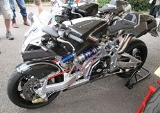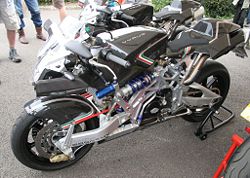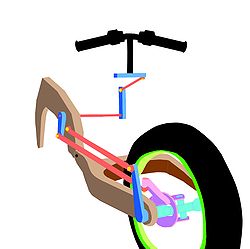
Hub-center steering
Encyclopedia


Motorcycle
A motorcycle is a single-track, two-wheeled motor vehicle. Motorcycles vary considerably depending on the task for which they are designed, such as long distance travel, navigating congested urban traffic, cruising, sport and racing, or off-road conditions.Motorcycles are one of the most...
s. Hub-center steering is characterized by a swingarm that extends from the bottom of the engine/frame to the centre of the front wheel instead of two forks.
The advantages of using a hub-center steering system instead of a more conventional motorcycle fork
Motorcycle fork
A motorcycle fork connects a motorcycle's front wheel and axle to its frame, typically via a pair of triple clamps. It typically incorporates the front suspension and front brake, and allows the bike to be steered via handlebars attached to the top clamp....
are that hub-center steering separates the steering, braking, and suspension functions.
With a fork
Motorcycle fork
A motorcycle fork connects a motorcycle's front wheel and axle to its frame, typically via a pair of triple clamps. It typically incorporates the front suspension and front brake, and allows the bike to be steered via handlebars attached to the top clamp....
the braking forces are put through the suspension, a situation that leads to the suspension being compressed, using up a large amount of suspension travel which makes dealing with bumps and other road irregularities extremely difficult. As the forks dive the steering geometry of the bike also changes making the bike more nervous, and inversely on acceleration becomes more lazy. Also, having the steering working through the forks causes problems with stiction
Stiction
Stiction is the static friction that needs to be overcome to enable relative motion of stationary objects in contact. The term is a portmanteau of the term "static friction", perhaps also influenced by the verb "stick"....
, decreasing the effectiveness of the suspension. The length of the typical motorcycle fork
Motorcycle fork
A motorcycle fork connects a motorcycle's front wheel and axle to its frame, typically via a pair of triple clamps. It typically incorporates the front suspension and front brake, and allows the bike to be steered via handlebars attached to the top clamp....
means that they act as large levers about the headstock requiring the forks, the headstock, and the frame to be very robust adding to the bike's weight.
Hub-center steering systems use an arm, or arms, on bearings to allow upward wheel deflection, meaning that there is no stiction, even under braking. Braking forces can be redirected horizontally along these arms (or tie rods) away from the vertical suspension forces, and can even be put to good use to counteract weight shift. Finally, the arms typically form some form of parallelogram which maintains steering geometry over the full range of wheel travel, allowing agility and consistency of steering that forks
Forks
Forks may refer to:*Fork, a pronged eating utensil*Forks, Washington, a town in the United States*Forks Township, Northampton County, Pennsylvania, a township in the United States*Forks Township, Sullivan County, Pennsylvania, a township in the United States...
currently cannot get close to attaining. The hub center steering's achilles heel, however, has been steering feel. Complex linkages tend to be involved in the steering process, and this can lead to slack, vague, or inconsistent handlebar movement across its range.
Hub-center steering systems have only appeared on a very few production motorcycles, and not with any great success. Evolution, rather than revolution, tends to drive advancements in new models, and dictate sales. After so many years of telescopic forks
Forks
Forks may refer to:*Fork, a pronged eating utensil*Forks, Washington, a town in the United States*Forks Township, Northampton County, Pennsylvania, a township in the United States*Forks Township, Sullivan County, Pennsylvania, a township in the United States...
, people are used to riding a bike that handles in a specific way, and almost expect the limitations, and compensation is part of the experience. Also there is a depth of knowledge known about fork based chassis design that attempts each year to get around the limitations through technological advances on the current system. Thicker and thicker fork tubes are used to reduce flex, special coatings are used to aid stiction, and greater and greater steering angles are used to counteract dive.
The hub-center steer concept is a very old one used as early as 1920 by Ner-a-Car, and enjoyed an aftermarket vogue in the 1970s through the work of Jack Difazio in the UK. The late Mike Tomkinson (of Mead & Tomkinson
Mead & Tomkinson racing
Mead & Tomkinson was a car and motorcycle dealership in Hereford and Tewkesbury. Three of the Tomkinsons, sons Chris and Patrick, and their father, Mike, successfully built and fielded racing motorcycles. They concentrated on the Isle of Man TT and on 24-hour and 8-hour endurance races at Spa,...
), aided by sons Chris and Patrick, pioneered the use of hub-centre steering in 24-hour motorcycle endurance racing. Their first machine, "Nessie" (qv), was powered by a Laverda 1000cc triple; but they later designed a Kawasaki-engined bike that became known as Nessie II. The Tomkinson's efforts encouraged Elf in the 1980s to create a succession of GP race bikes. In the 90's there was a flurry of action, first was the Bimota Tesi 1D in 1991 (designed by a young Massimo Tamburini
Massimo Tamburini
Massimo Tamburini is an Italian motorcycle designer for motorcycle companies including: Cagiva, Ducati, MV Agusta; and Bimota, which he founded, together with Bianchi and Morri ....
of 916 fame) however this was expensive and was only ever produced in small numbers. Then in 1993 Yamaha
Yamaha
Yamaha may refer to:* Yamaha Corporation, a Japanese company with a wide range of products and services** Yamaha Motor Company, a Japanese motorized vehicle-producing company...
launched the GTS1000
Yamaha GTS1000
The GTS1000 is a sport-touring motorcycle introduced by Yamaha in 1993, sold until 1994 in the United States, and sold elsewhere until 1996. It is notable for its innovative forkless front suspension, specifically a RADD front suspension designed by James Parker...
based on James Parker's RADD design. It raced at the Isle of Man TT
Isle of Man TT
The International Isle of Man TT Race is a motorcycle racing event held on the Isle of Man and was for many years the most prestigious motorcycle race in the world...
but was always blighted with a reputation for being a bit heavy and clumsy in use. In 1995 Michael Tryphonos built a prototype based on the Defazio system that did race at the Isle of Man with some success reaching 11th in the Senior TT.
Royce Creasey, designer of feet forwards motorcycle
Feet forwards motorcycle
A Feet First Motorcycle is a class of motorcycle design that seeks to look at the two-wheeled concept afresh, and create a new form of practical personal transport...
s, is an ardent advocate of HCS.
Currently, Bimota
Bimota
Bimota is a small, Italian manufacturer of custom and production motorcycles. It was founded in 1973 in Rimini, Italy by Bianchi, Morri and Tamburini. The company name is a portmanteau derived from the first two letters of each of the three founders' surnames, i.e...
's Tesi 3D and the Vyrus 984C3 2V and the 985C3 4V are the only production motorcycles using hub-center steering systems, however Italjet also use hub-center steering on their top of the range scooters with much success. Sidecar manufacturers occasionally employ hub-center steering in their designs. A notable example being the GG Duetto
GG Duetto
The GG Duetto is an exotic high performance motorcycle-sidecar combination built by Swiss manufacturer Grüter + Gut Motorradtechnik GmbH between 1994 and 1999. Approximately 30 units were produced....
.
External links
- Steering For The Future by Tony Foale - Expert article on alternative motorcycle front suspension systems

